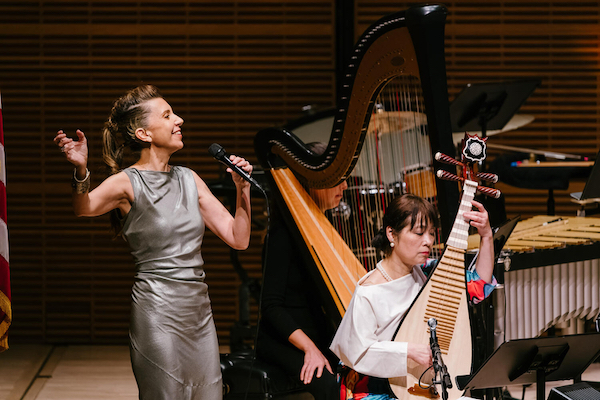This year, a century since the Weimar Republic’s “golden years,” seems as good as any for Carnegie Hall’s concert series “Fall of the Weimar Republic: Dancing on the Precipice.” The Knights, the Brooklyn-based orchestral collective that never fails to do something interesting, contributed a creatively imagined program of music from and inspired by that time in Europe.
As is their wont, they stretched the theme. Along with Kurt Weill and Maurice Ravel, the program included songs by Bob Dylan and contemporary Brazilian songwriter Chico Buarque. Most conspicuously, it featured the world premiere of Ears of the Book, a stunning new work for pipa and orchestra by Chinese-American composer Du Yun.
Smartly, The Knights opened with the ear-friendly Le Tombeau de Couperin by Ravel. Ravel was, of course, French, and not directly affiliated with the culturally fecund post-World War I German republic that collapsed under Nazism in 1933. But the contemporaneous Tombeau was the composer’s tribute to the war dead.
For its four parts Ravel took inspiration from antecedent forms of the French Baroque exemplified by Couperin. Under the baton of fearless co-leader Eric Jacobsen, The Knights put a glistening sheen on the perpetual motion of the Prélude. The Forlane was appropriately arch, graceful and incantatory, with a light, almost winking feel. The Knights displayed one of their great strengths here in producing from the full orchestra a homey, intimate sound.

That made the dramatic swells of the Menuet all the more effective. Then in the Rigaudon the orchestra achieved an almost conversational dynamic, with a big assist from the featured oboe (a callback to the Prélude). The slower section of the movement was warm and enfolding.
The Knights Plus One
Enter Wu Man and her pipa. This Chinese plucked lute can also sound at times like a kind of zither, at least in the hands of this virtuoso. For Ears of the Book Du Yun specified an array of techniques, some quite non-traditional, all performed with virtuosity and flair by Wu Man.
But as the composer said, it’s not about the techniques. “When culture happens, it’s always about encountering,” she said – cultures and traditions meeting one another, each progressing the richer for it. With a philosophy like that, one can relate just about anything to a time-and-place theme like the Weimar Republic.
For sure, the music did have plenty of unease and violence. It’s built on the metaphor of 10 different “Polaroids” with subjects like “A Mist,” “A Wild Beast, “Marigold,” and “An Infinite Well.” But these run together episodically, creating a journey of unease and violence with a sense of decisive agency nonetheless.
The piece begins with a pipa solo accompanied by ghostly shivers and moans from the orchestra. Dissonant punctures establish the orchestra’s firm presence, followed by an aggressive cacophony of sawing. The music progresses with much athletic work on the pipa, a lot of percussion, a slathering of grim atonality, and a huge variety of textures from both soloist and orchestra.
At times it made me feel physically uncomfortable – but in a good way, feeling the presence of a massively imaginative spirit finding expression through a collective of smart, game realizers who embody the best of creative 21st-century performance synthesis.
The Young Weill
Kurt Weill wrote his Symphony No. 1 in 1921 when the young composer hadn’t yet become the Kurt Weill we know from his famous opera/cabaret music. I hadn’t heard this symphony before, and it took a while after its heavy, angsty start for me to start appreciating his version of the Romantic-influenced Expressionism of the time.
Fortunately the Knights gave it a strong performance that allowed Weill’s early flair for orchestration to shine. Colors were sharply delineated, electric energy corralled with gusto. The chorale-like quiet section sounded especially magnetic in context, and the viola soloist acquitted himself marvelously.
Oh, Show Me the Way…
The concert’s chipper little closer, a forgettable arrangement for two singers and orchestra of Brecht and Weill’s classic “Alabama Song,” didn’t score with me, seemed gimmicky. Much better was a fiery, heart-rending arrangement of Bob Dylan’s “When the Ship Comes In.” Knights violinist and vocalist Christina Courtin arranged and sang both, accompanied in “Alabama Song” by Alex Sopp, a Knights flutist. These soupçons of fun, displaying members’ multiple talents, was a very Knights thing to do.

Jazz singer-songwriter Magos Herrera joined the orchestra for Colin Jacobsen’s arrangement of “Geni e o Zepelim,” from an opera by the Brazilian songwriter Chico Buarque. Singing in Spanish and emoting in full cabaret mode, Magos conveyed elegantly the horrid story of a poor, cross-dressing prostitute who sacrifices her pride and more to save her town only to be rewarded with continued derision from her fellow townsfolk.

Both “When the Ship Comes In” and “Geni e o Zepelim” took inspiration from Brecht and Weill’s Weimar classic “Pirate Jenny” from Threepenny Opera. The Dylan song’s connection is rather obscure; the Buarque’s is more forthright. But that’s right in keeping with the wide net The Knights cast when they take on a theme.
 Blogcritics The critical lens on today's culture & entertainment
Blogcritics The critical lens on today's culture & entertainment




